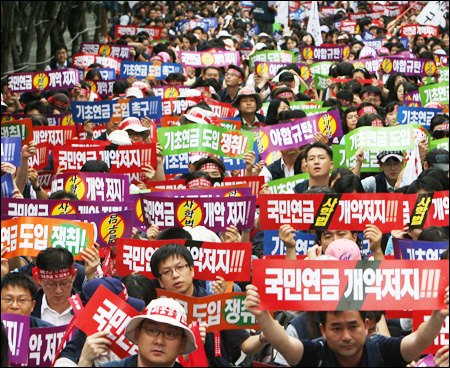
Pension crisis looms larger

National pension funds expected to be depleted by 2053
The retirement plans of future workers have been put in doubt by Korea’s growing pension crisis with a workforce aging in dog years suggesting the national pension pot could be depleted quicker than the previously-anticipated 2060.
This is an alarming prediction for a country where people are already dealing with income shocks when they retire. The depressing experience of Greece highlights the risks of relying on state coffers and tax payments to expand provisions and benefits. And the country’s woefully underdeveloped market for private pensions doesn’t inspire confidence.
Not that the National Pension Service has been living up to it’s billing as the country’s marquee social safety net for old people as less than 30 percent of over-65 Koreans are on the receiving end of a basic state pension. And only 20 percent of economic active people are signed to private pension programs, which threatens future generations of taxpayers with an intolerable burden of welfare obligations.
Korea also has the highest employment rate of those over-65 at around 30 percent as more and more workers begin to accept they will have to work till they drop because they can’t afford retirement.
Korea has been the world’s fastest aging economy in recent years and a study by the National Assembly Budget Office (NABO) doubled as criticism that the government has been undervaluing the negative effects of the aging population on the public pension system.
Analyzing figures from Statistics Korea and the Financial Supervisory Service (FSS), the parliamentary report suggested the national pension will be running at a deficit by 2041, three years earlier than government expectations, and depleted by 2053, seven years sooner than anticipated. At the end of April, the NPS managed funds of 367 trillion (about $321.3 billion) won.
Although the majority of the aged population is left out of the public pension system, policymakers are wary of spending more state funds to expand payments to old people, prating ad nauseam about avoiding a Greek mistake. The accelerating retirement of the baby boomer generation, those born in the era of fecundity that was the 1950s and `60s, adds to concerns over financing the public pension program.
The private pension market has been growing at a fast pace in recent years, with 52 trillion won in reserve funds measured at the end of May representing more than a 40-fold increase from five years earlier.
However, Samsung Securities economist Woo Jae-ryong believes that the market should be at least five times bigger than it is now to prevent workers from an acute squeeze in living standards after retirement. Samsung predicts that the private pension market will likely grow 12 percent annually for the next 10 years.
“Considering the poor coverage of public pension programs, it’s critical that the private pension market expands to defuse the threat of retirement poverty,’’ Woo said.
The proportion of those on a public pension among the over-65 was measured at 31.8 percent at the end of 2011.
Beneficiaries of the National Pension Service (NPS) accounted for 28.3 percent of those over-65, with 3 percent benefiting from the pension fund for civil servants and 0.4 percent receiving an annuity from the teachers’ pension fund.
The average age of Korean workers is expected to be 50 by 2045 when it will be the highest in the world. Potential growth will decline from 4.2 percent in 2011 to 2.5 percent in 2050, when the average worker will be supporting 1.65 pensioners.
The demographic shift is expected to have a significant impact on the country’s growth, fiscal spending and private savings levels. <The Korea Times/Kim Tong-hyung>


